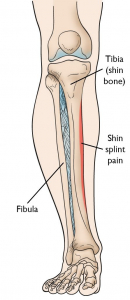Shin Splints
Shin Splints (Periostitis)
By Aaron Woolley, Physiotherapist Gold Coast.
Shin splints and shin pain while running is a common and often frustrating issue which can affect all runners ranging from the causal/recreational runner, to the elite athlete.
Shin pain can be felt in two distinct regions. Firstly, the anterior (front) portion of the tibia which is often related to a muscular origin. Secondly, medial (inside) shin pain along the inside border of the tibia is due to inflammation the periosteum (periostitis) which lines the outside of our bones. Clinically this condition is called medial tibial stress syndrome, but it is often called shin splints.
It’s important to note that specific pain and tenderness along the bone the of the tibia (lower leg) can also be a sign of a bone stress injury/stress fracture. Therefore, seeking medical advice is recommended for all people suffering with shin pain. If you’re experiencing shin pain but unsure of its origin the Physiotherapists at Robina Physio on the Gold Coast can help diagnose and treat you effectively.
What Causes Shin Pain/Shin Splints?
Shin splints typically occurs following sudden changes in physical activity, particularly running loads. These changes include frequency, intensity, volume, terrain or even changes in technique and/or footwear. Examples can include, sharply increasing the number of training days, running longer distances or trying to adopt a forefoot running style incorrectly. We also see shin splints occurring frequently after returning to running from a period of rest e.g. after the offseason.
How Does Shin Splints Present?
Shin splints are characterised by pain along the inside border of the tibia. Swelling in the area may or may not be present. It is common for shin splint related pain to:
- Be dull and throbbing progressing to sharp and razor-like
- Occur both during and after exercise
- Often worse at the beginning of running, gets better as you warm up, then worse again following running
- Aggravated by touching the inside portion of the shin
Common findings?
Muscle weakness and reduced flexibility of the ankle are major features associated with shin splints. The major muscles affected are the Gastrocnemius and Soleus (calf muscles).
The human body works as one large functional unit and not just a combination of separate limbs. So, it is crucial we look above and below the shin as well. Foot biomechanics can often be altered in shin splints. But more commonly we see hip and pelvic muscle weakness on both the affected and non-affected side.
At Robina Physio on the Gold Coast, we have an added layer of knowledge and therefore understand that it is never as simple as one specific region or joint causing the issue and will explore all components that are leading to your shin pain.
How Are Shin Splints Treated?
The first step in managing shin pain is all about load management. This often requires slightly decreasing your running initially, followed a graduated build-up of running volume and intensity. Getting this process right is the key to success, this enables re-building of tissue tolerance of the bones, tendons and muscles of the lower limb. Bone can be very unpredictable with how it responds to training, so guidance from an expert practitioner like at Robina Physio on the Gold Coast is very important.
The next step of the process involves 2 equally important parts. Firstly, we need to loosen the tight structures around the lower limb. This can be done with soft tissue massage, dry needling and stretching exercises. Secondly, we need to strengthen your calf muscles and the muscles controlling the biomechanics of you lower limb. This would include calf raises, glut maximus, medius/minimus and core stability exercises.
Finally, in some cases footwear modification or orthotics may be considered. According to the research, the jury is still out as to whether orthotic therapy works for shin splints. In certain people orthotics will be very helpful, but not everyone. A great way to test if shoe modification or orthotics will help is to briefly strap the foot and replicate what a foot orthosis might do. A positive outcome is suggestive that a more supportive shoe or orthotic will be useful.
If you are experiencing shin pain here are a few of things you can try at home to help manage your shin pain. 
- Calf Stretch – Hold for 30 seconds and repeat up to 3 times. (Pic from Telehab)
- Foam Roller – Roll your calf muscles for 10 mins following every run.
- Ice Cube Massage – Firmly massage the ice cube up and down the shin until it melts. It ok for this to be a little sore.
If you’re struggling with shin pain and/or shin splints the team at Robina Physio on the Gold Coast are here to help and share our knowledge and expertise. Contact Us on (07) 55787233 or BOOK NOW online.




